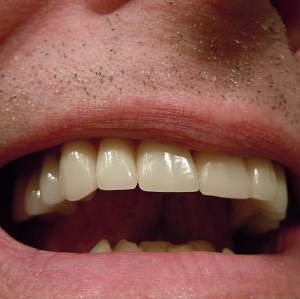
A crown is a tooth-shaped cap that’s placed over the visible part of a damaged tooth to restore its shape and appearance, and to make it strong again.
Crowns can be made from different materials such as porcelain, metal alloys, ceramic or zirconia (a man-made crystalline material).
Crowns are used to:
- Restore severely broken-down teeth, where fillings can’t be applied because the destruction of the teeth is too extensive.
- Restore severely worn-down teeth. Some people grind their teeth extensively, resulting in collapsed bites that are built up with crowns.
- Restore teeth that have become brittle and susceptible to fracture after root canal therapy (which results in the blood supply being cut off). The crown protects the tooth from the stress of biting and chewing.
- Restore implants. Extracted teeth can be replaced with implants, which are surgically placed in the jaw bone at the site of the missing tooth. Implants are also restored with crowns.
- Replace missing teeth. If you have missing teeth, your dentist can close the gaps in your mouth with dental bridges. Bridges consist of crowns on the teeth on either side of the missing tooth, and a pontic (false) tooth in between.
- Cosmetically restore your smile (e.g. if you have a discoloured or badly shaped tooth).
What to expect
Your dentist will help you to determine which type of crown is best for you. He or she will then prepare your damaged tooth to a shape that will fit the crown. Once this is done, an impression will be taken of the tooth and the crown will be prepared to fit its shape.
The way in which a crown is prepared depends on its purpose and the material used to construct it. Temporary crowns can be made in the dentist’s consulting room, whereas most permanent crowns are made in the lab – either via impressions or digital scanning. You will be fitted with a temporary crown, while your permanent crown is being made.
Once constructed, the permanent crown can be fitted to the prepared tooth using one of several available bonding techniques.
Most crowns require two visits to the dentist.
Complications and how to prevent them
Crowns can, unfortunately, fracture or fall out, resulting in the crown needing to be redone or re-cemented. If you have a crown, special care should also be taken when cleaning your teeth, as the join (or margin) between the tooth and crown is susceptible to decay.
Follow these steps to make your crown last longer:
- The crown join is placed just under the gum level, so your toothbrush must be angled at 45 degrees to the gum when you’re brushing. This will help to keep the crown margin clean and prevent decay.
- Brush gently, twice a day.
- Floss every day and floss between all your teeth.
- Consider using an electric toothbrush and Aquaflosser, both of which can help keep your mouth clean.
- Rinse your mouth after eating and drinking, especially if you’ve had sugar-containing foods or beverages. Ask your dentist to recommend a good mouth rinse.
- See your dentist and oral hygienist regularly.
Written by dentist Dr Lance Videtzky of City Dental Care, Cape Town. (B.D.S.) Rand. February 2019.
Read more:
- Fillings




 Publications
Publications
 Partners
Partners
















